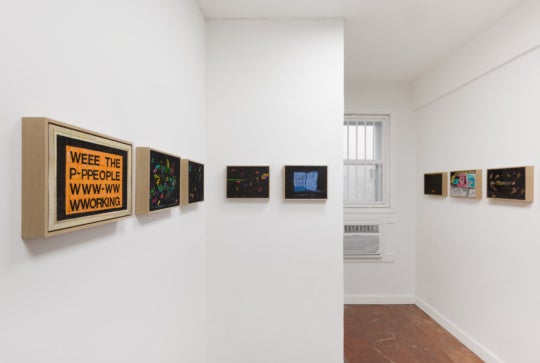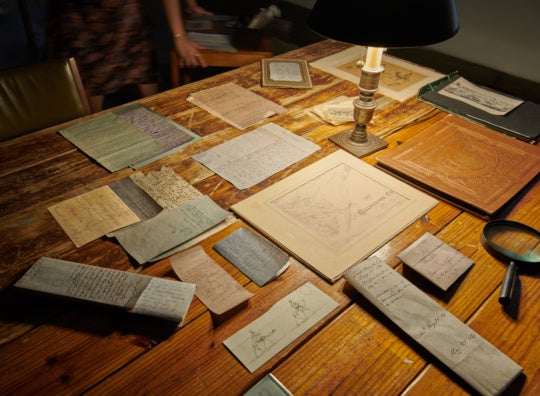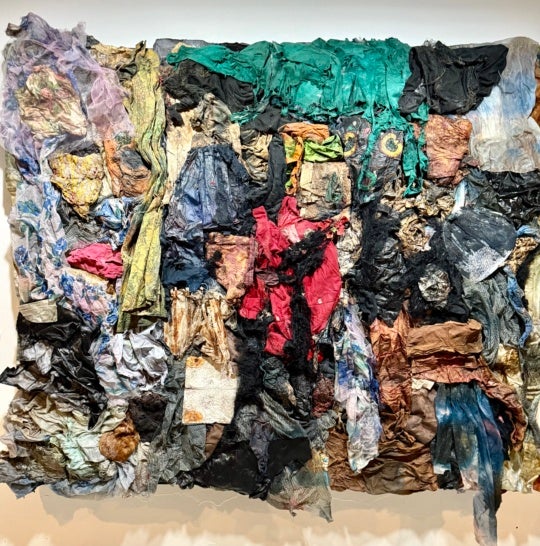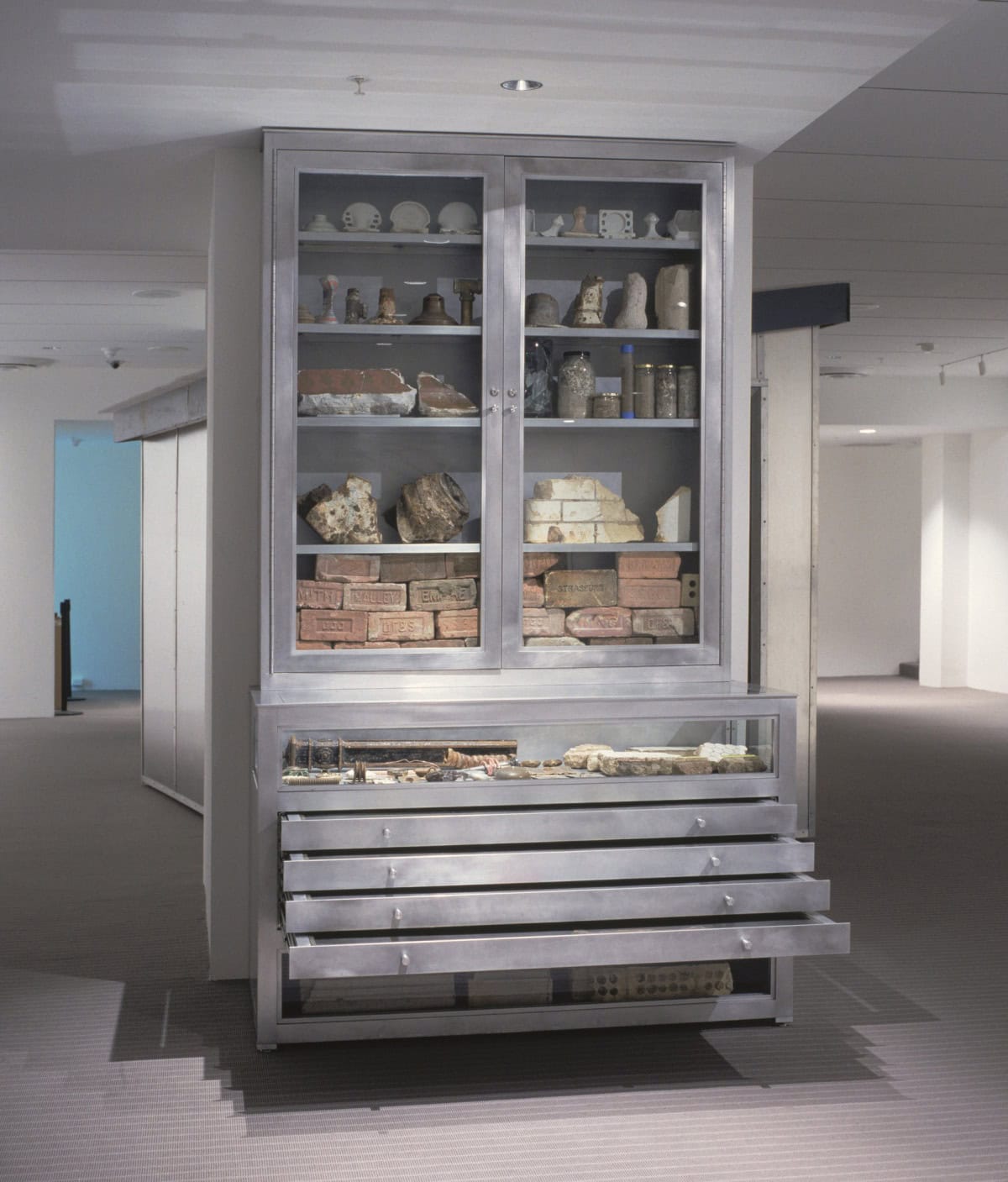
Mark Dion is a contemporary artist who blurs the lines between naturalist, artist, and archaeologist. He creates sculpture and installation that often refer back to pseudo-scientific ways of collecting in order to explore contemporary material culture, knowledge, nature, and their subsequent institutionalization. Spawned from the Whitney Independent Study Program, a program that has supported the likes of Renée Green, Andrea Fraser, Gregg Bordowitz, and Miwon Kwon, Dion is one of a collection of artists and scholars who have become dominant figures in the contemporary art world. He accredits the ISP for his dynamic arts education, and has since developed a particular view of art education that values artistic culture as much as technique. Consequently, Dion helped create Mildred’s Lane, a multidisciplinary residency program in rural Pennsylvania that attempts to formalize the informal aspects of the art school environment.
Dion’s Tate Thames Dig from 1999 offers one example of the ways in which the artist destabilizes the lines between art and science. Inspired by 16th century curiosity cabinets, the aptly named Tate Thames Dig was composed of a double-sided mahogany chest that Dion filled with objects collected from the banks of the river at low tide. Interested in specialized scientists who work to communicate their findings to the broader public, Dion’s practice focused on providing access for public participation. The dig was conducted by Dion and a group of volunteers who collected everything from gum wrappers to broken pottery. The material was sorted and displayed on the south lawn of the Tate Britain where museum visitors were able to view the day’s findings as well as maps that identified sites where collection took place. By combining subjective, objective, and aesthetic means of categorization, Dion offered viewers a chance to reflect upon the value of contemporary material culture. The double-sided chest, with its array of drawers, allowed viewers to explore and discover remnants of contemporary culture within the highly institutional space of the Tate. Though Dion adamantly says that he is not anti-institution, particularly when it comes to natural history, the presentation of discarded objects within the art museum does ask the viewer to question how value is attributed to various objects.
In addition to his sculptures, Dion’s installation work further departs from traditional notions that define the art object, and enables moments of discovery usually reserved for scientists. During inSITE 2000 he created a bird-watching house on an estuary along the Tijuana — San Diego border, and invited viewers to become amateur bird-watchers. In 2003 he created Urban Wildlife Observation Unit through the Public Art Fund, which similarly offered a research center for visitors to learn about the wildlife of New York City’s Madison Square Park. At the site, visitors were given a field guide in which the artist had published a series of illustrations identifying the inhabitants of Madison Square Park, including the European Starling, the House Sparrow, the Pigeon, the Monarch Butterfly, the Norwegian Rat, and the American Cockroach. As installation art merged with scientific observation (and an undeniable wit), Dion wove the Unit and the resulting field guide into the fabric of contemporary art.
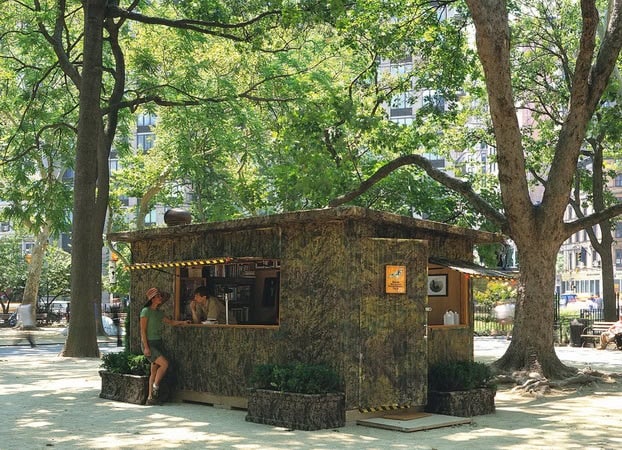
This past January, Mark Dion was invited to speak as a part of the programming for Georgia State University’s Center for Collaborative and International Arts (CENCIA). With an antiquated slide projector, Dion guided his audience on a tour across the world as he presented them with a number of images from his many projects. Much of Dion’s work looks to the past to reveal how subjective authority informs the production and distribution of knowledge. By taking the guise of a 19th century naturalist, viewers are invited to question the implied logic of the exhibition hall, as well as the omniscient voice of institutional authority. It is not Dion’s intent, however, to dismantle the institutions of science; what his work does instead, is open up opportunities for both himself and his viewers to question, explore, and make discoveries for themselves.
Popular career advice urges the importance, even necessity, of specialization in the contemporary job market. This path to professionalization, which encourages students to acquire a depth of knowledge in one subject at the expense of a broader, interdisciplinary edification, has had a profound effect on higher education in the United States. The resulting devolution of institutional higher learning into mere job mills has produced resistance in academia. This is where programs like CENCIA come in. CENCIA gathers creatives from around the globe to Georgia State University in order to engage students in interdisciplinary research and help them develop partnerships with leaders from a number of different fields. Programming in 2010, for instance, filled the Ernest G. Welch Gallery with works from Milanese curator Marco Scotini’s internationally-acclaimed Disobedience Archive. As part of the programming, CENCIA enabled the Georgia State Center for Human Rights and Democracy and the Consulate General of Argentina to co-host a symposium featuring Scotini; co-director of the Center for Human Rights and Democracy, Fernando Reati; Peruvian arpillera expert, Tami Randahl Morris; Art Papers editor, Sylvie Fortin; and artist Kara Walker.
Pam Longobardi, an artist whose own approach is highly multidisciplinary, will bring artists and scientists together next month to discuss environmental issues in a CENCIA-sponsored symposium entitled The Nature of Waste. In an interview last week, Longobardi said that Mark Dion’s exploration across disciplines made him a natural choice for inclusion in the programming, providing a preview of sorts for the discussion on April 14th, which will feature British photographer Andy Hughes, naturalist Wayne Sentman of the Oceanic Society, and Howard Ferren, Director of Conservation at the Alaska SeaLife Center.
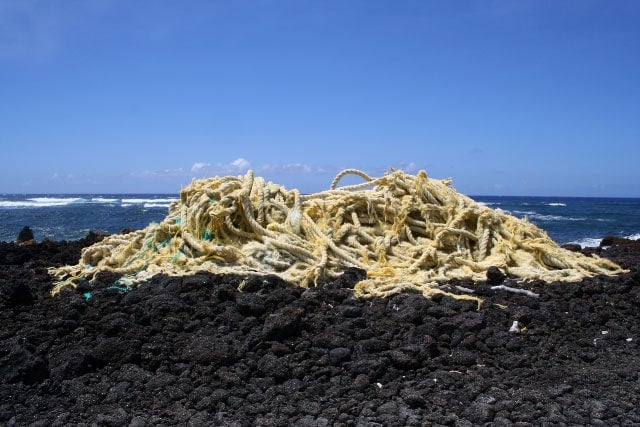
Georgia State is hardly alone in providing a forum where interdisciplinary work is encouraged. From collaborations between American neuroscientists and Tibetan monks and nuns in Emory University’s Emory-Tibet Science Initiative to Georgia Tech’s Poetry at Tech program, which brings some of today’s most consequential writers to Atlanta, academic institutions are finding ways to engage significant thinkers from wildly disparate fields in fruitful conversation. But there is no reason why this sort of thinking has to stop at the academy. In Atlanta, we have multiple organizations working to serve the arts community. While it makes good sense to create dialogue amongst ourselves, it is to our benefit to recognize that we exist within a larger community – one that we can actively engage with to produce exciting results. As Longobardi mused, “[There are] these segregations of ‘worlds:’ the ‘art world,’ the ‘science world.’ That’s the old model. It’s just ‘the world.’”
The aesthetics that result from this blurring of fields will be difficult to predict, but border-jumpers have appeared throughout history. That’s one reason we find Leonardo da Vinci so compelling. If an economist listens to a sculptor’s presentation at the TED talks, it’s unlikely she’ll become a less effective statistician. A multidisciplinary method, rather, permits experts to take what they’ve learned from other fields and create innovative solutions within their own specializations.
Dion’s display practices probe the ways in which value is attributed to both art and science. Atlanta universities seem to be paving the way for the cross-pollination of disciplines, but there is room for the non-profit sector to seek new forms of collaboration as well. Los Angeles organizations like the Center for Land Use Interpretation and Machine Project have been very successful at making rarefied knowledge accessible, while also remaining rooted in the field of contemporary art. Marina Abramović said recently in Paul Boshear’s interview that art is about context; to quote her loosely: someone that makes bread in a bakery is a baker, but someone that makes it in an art gallery is an artist. That statement, which is as profound as it is contentious, creates the conceptual space for artists in Atlanta to address the blurred distinctions between disciplines prevalent in today’s culture.
In the same way, artistic practice is not necessarily diluted when it meets with other disciplines. In order to avoid creating soulless, didactic work, artists need to take a nuanced, subtle approach. Artists who are committed to wrestling with the things that they care about will eventually work out and fine-tune solutions in such a way that the aesthetics will take care of themselves. And as long as artists continue to create work that engages with the rest of the world, there is no doubt that how we talk about aesthetics, visual culture, and cultural value now will continue to thrive in all of its colorful vivacity in the future.

